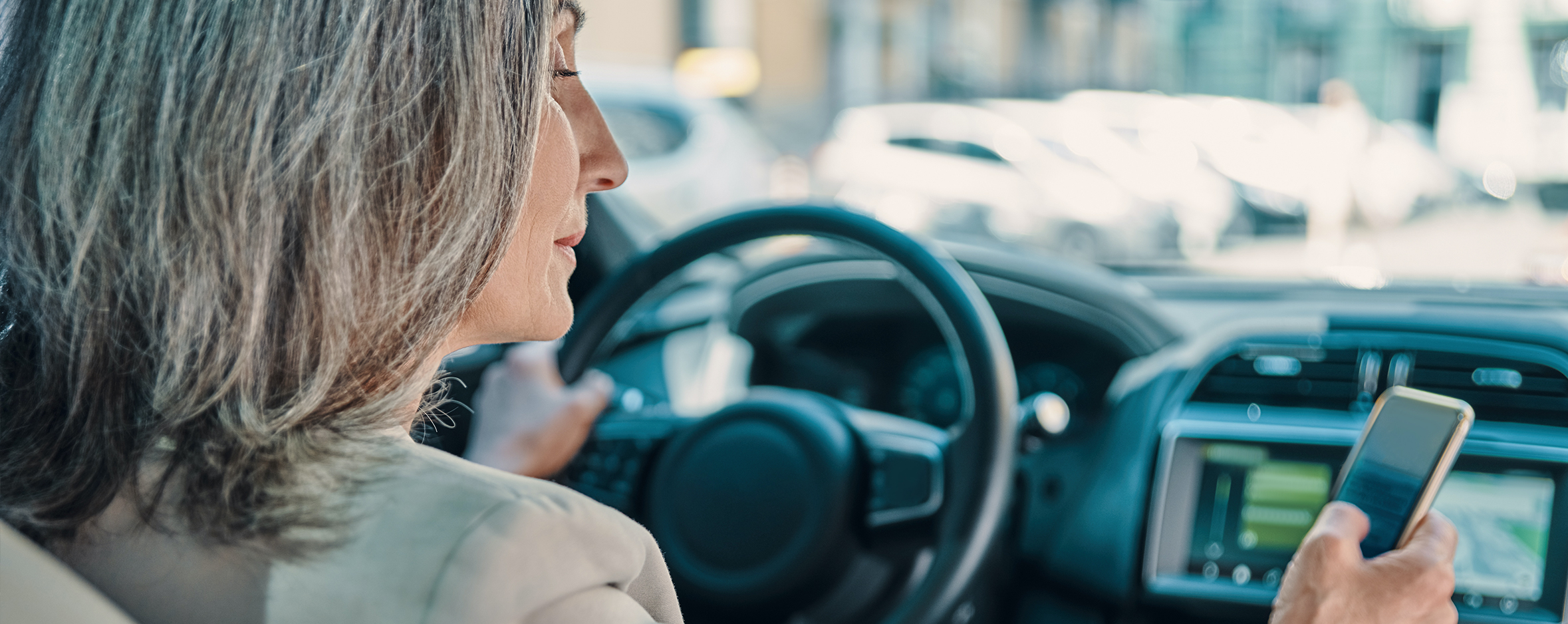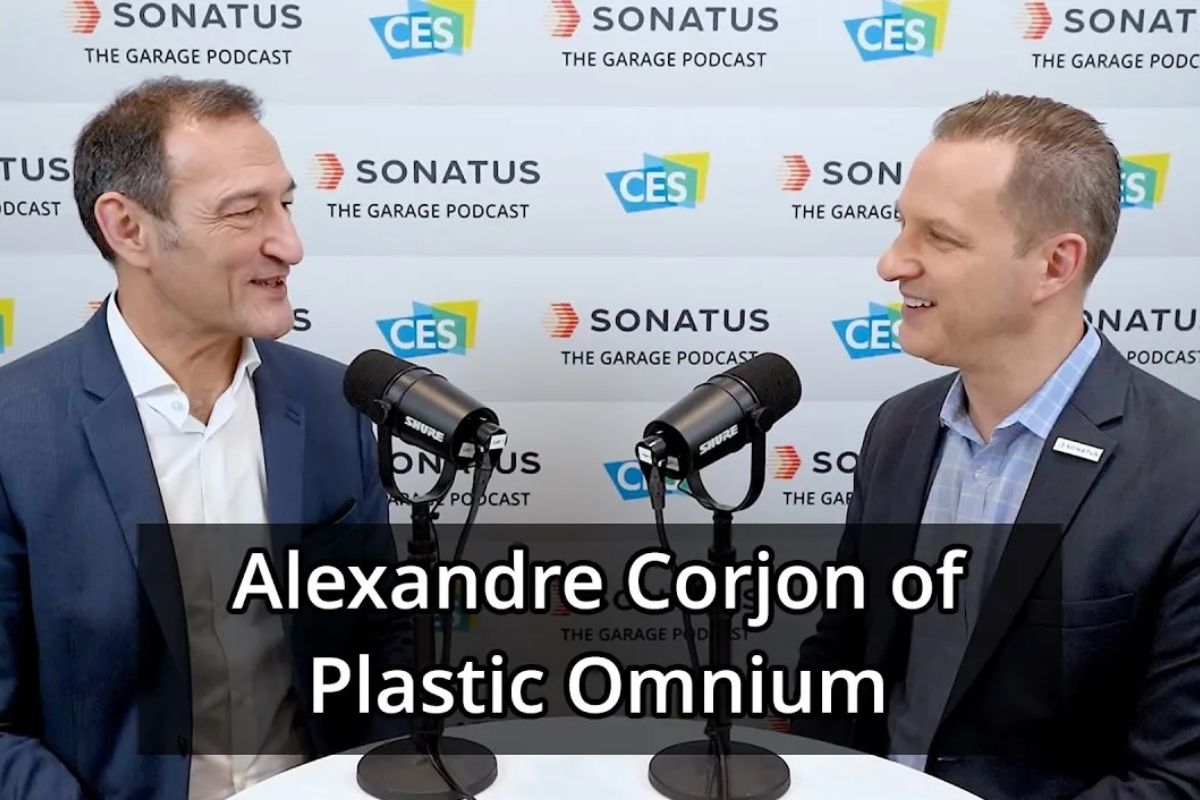The Garage Podcast : S2 EP2
Alexandre Corjon of Plastic Omnium
At CES 2024, Alexandre Corjon, EVP of Innovation and Software from Plastic Omnium sat down with John Heinlein, Ph.D., Chief Marketing Officer of Sonatus to discuss diverse topics ranging from vehicle software, dynamic vehicle lighting, the future of hydrogen vehicles, usage-based vehicles, and much much more, including the joint CES demonstration between the two companies.
Listen to audio only version:
Episode Transcript | Alexandre Corjon of Plastic Omnium
Table of Contents
- Overview
- Meet Alexandre Corjon
- Introduction to Plastic Omnium
- Dogs and cats!
- Industry trends for EV and Software
- Consolidation of software in vehicles
- Central compute
- Automotive Ethernet and TSN
- Vehicle cybersecurity
- Plastic Omnium - Sonatus CES Demo
- System thinking with sensors
- Evolving regulations for lighting
- Other focus areas of Plastic Omnium
- Changing mobility
- Conclusion
Overview
Today in The Garage, Live from CES 2024, Plastic Omnium. Let’s go!
Welcome to the Garage. Today we’re recording another episode live at the Consumer Electronics Show 2024 in Las Vegas. Today, our guest is from Plastic Omnium, we’re pleased to welcome Alexandre Corjon, EVP of Innovation and Software. Alexandre, welcome to The Garage. Thanks for the Welcome, John. I will be very glad to be here today with you, thanks!
I’m so excited to welcome you. We’ve been working together and I look forward to talking about that. But let’s start by introducing you to the audience. Tell us a little bit about you.
Meet Alexandre Corjon
So I’m Alexandre Corjon, as you said, I’m EVP for Innovation and Software at Plastic Omnium. I started my career in research first, then I joined a big aircraft manufacturer, Airbus, during 14 years and then the Alliance, Renault-Nissan, starting in automotive and discovering a totally new world. I have joined Plastic Omnium two years and a half ago, and this job is quite exciting because it gives you the chance to work with Sonatus. That’s very kind of you to say, but such a great partner and we’re going to get into that. Tell us a little bit about your role in what your scope of responsibility is.
In fact there is two types of roles: the innovation part it’s coordinating at the level of the corporate for innovation, every team in different divisions of Plastic Omnium so we are here to try to make synergies across the innovation but also to bring new topics that can enrich the portfolio of Plastic Omnium. And the other side we have created the entity dedicated to software – software is becoming so important in automotive — which is called OP’nSoft and the goal of this entity first is to develop software for all the products of Plastic Omnium, right, but afterwards the ambition is really to go towards software as a product and even pure software sales and adding a new stream of growth for Plastic Omnium.
Introduction to Plastic Omnium
Ah, very good. Very good. And for our viewers who may not be familiar with Plastic Omnium, can you tell us a little bit about your key products and your key focus areas?
So Plastic Omnium was created just after the second world war, and the idea is in the name: bringing plastic parts to [lighten] the vehicles. But from that the portfolio has totally changed: we have now five divisions. One which is dealing with lighting, so really bringing visibility to the vehicle. One dealing with the exterior part still in plastic. One with the front end module, so the first part of the car. A division on the clean energy system where we are doing your fuel tanks, but also battery/EV pack and also the electronics which is related to that. And the last one is new energy, where we are delivering a product for the hydrogen– high pressure vessel for the storage of hydrogen–-and fuel cell system to produce from this hydrogen, which is stored in the vessel, electricity to power the car.
Dogs and cats!
That’s fantastic. That’s quite a wide range. And we’re going to get into some of those topics. I also—before we get too far into the meat of our discussion—I always like to begin our conversation to get to know our guests. And I always ask my guests to tell us something fun something interesting about you. So what’s something interesting that you can share with our guests?
I think perhaps something which is really funny. I’m married, but that’s normal, I would say not funny. I have two children, not funny as well. But now I have a third, “Bébé d’amour,” as we say in France, is my dog. But it’s not a dog. It is a golden retriever. So it is my third child.
Golden Retrievers think they’re people. Yeah. They’re convinced they’re people. And sometimes I’m convinced too. Well, I always promise to meet my guests by telling them a fun fact about me. And so we have, I’ve always wanted a dog but my lifestyle doesn’t support a dog. So we have a cat. But actually, we’re about to get our second cat. So actually the cat has been born and it’s now with its mommy and we’re waiting for it to get…they are usually about 12 weeks, I think, when they leave their moms. So, late in February, we’re getting our second cat. So we’re very excited. Perhaps I will have a second dog. Ah, could be! I think two cats is less work than two dogs. Yeah, I’m sure.
Industry trends for EV and Software
All right. So let’s get into the conversation. And maybe we can start by getting a sense of what are some of the things you’re seeing both in the industry, perhaps, and in the show? What’s exciting topics you’re seeing right now,
Perhaps in the industry first. I think we thought the evolution of the automotive industry has been continuous just since the beginning. But currently we are really a turning point where we see first the real growth of EV vehicles, which is also disrupting the market in terms of who is the leader in this market and we see the, I would call them, not the traditional OEM, who are losing ground in this domain and also the software appearance in the vehicle and everyone is talking about software in the vehicle. But it’s becoming a reality.
Yeah, it’s right. And we’ve had a number of guests this week. And we’ve talked about how software defined vehicle has been kind of a buzzword for a while. And I feel like, little by little, it’s now beginning to be real. We’re showing off a number of demonstrations, including one with you, we’ll talk about a little later, where we’re using software to do really, I think, incredible innovation, but it feels like the software is becoming more real, now in vehicles. Of course, software has been vehicles for a long time. Yes, but it’s been buried and embedded. And now it’s becoming more on the surface. I think.
If you’re looking to my own history, in fact, we started the software defined vehicle in 2016, right. And in fact the main idea, we were looking to the architecture of the vehicle, which was with too many controller units. And in fact, it was very difficult to pass information from one to the other, right. And the idea was really to have some kind of full virtualization of the car, like in the IT department. But in fact, we move a bit from this idea and going for this HPC, high performance computing. And I think it’s mandatory because from the user point of view, you are expecting that your car is evolving, which can be transformed continuously, right. And having this big computer, it makes life easy to combine functions, to upgrade them, and to deliver something which is new for the consumer. And everything has software now. Your coffee machine, I’m sure. The watch. Yeah, my coffee machine tells me it is ready for a software update.
In fact it’s totally crazy, because a few years ago, we could not imagine that the coffee machine will be more smart than us. My coffee machine, I have an Nespresso—I’m a big fan– my coffee machine reads barcodes, right? And it says “Ah, for this pellet I need to spend at this speed”. “But this pellet is different, for this I have to spend at a different speed”. So it’s very true.
Consolidation of software in vehicles
But coming back to to cars, we definitely see this consolidation. And we see the coexistence of multiple applications, multiple functions side by side, as one of the—I think for me—one of the critical defining factors of a software defined vehicle because, we also said a hardware-defined vehicle this block does this, this one does that. And that’s that. But as soon as you have multiple things in one block, well, then all of a sudden, they have to coexist. Yeah, not unlike data center.
In fact, it’s exactly the same. I know that Sonatus has a lot of experience in data center. And I think it’s the right bridge with what is happening in the car, because the technology was existing in other domains, but it has to be adapted to the vehicle, because the notion of safety, notion of cybersecurity is very critical, because you have people moving inside. So we need to be sure that they will be transported without, let’s say, additional safety issue. That’s right. And so it’s, it’s what makes it different with the car compared to other industries.
Central compute
Yeah. And you talked about this consolidation. And I think this idea of central compute… it’s kind of a journey, because it’s not like binary, we flip a bit and all of a sudden, we have a big server in the trunk. And that’s that, and we’re done. Because it’s not like that. Because first as you say automotive applications don’t lend themselves and you need to be safety aware, you need to be aware of mixed criticality, some systems are safety critical, some systems are not. Also, there’s physical wiring in cars, you know, zonal architecture is one of the trends that we see is coming, providing a lot of value, simplifying, you know, simplifying and, lightening – reducing the weight, I should say – of the wires in the car, having local runs, it’s also allowing us to bring in things like automotive Ethernet, and more modern networking technologies, because those are critical to being able to deliver new capabilities post production,
Automotive Ethernet and TSN
Sure and in fact, we need to update the car. I think today, people are used to have a product which is evolving with their own willingness. And I see we need to bring automotive, which is one of the major objects they are using in the same mood. Yeah, I think I want to come back on the Ethernet because it’s sure it’s not exactly the same ones that we have at home, because it has timestamps. That’s right, time sensitive networking, exactly. Because you need to be sure that the information that you receive is the proper one, because you cannot ask to brake when there is no need of braking, right. And you need also to secure that you brake when it’s needed. But you see also with software defined vehicle in the architecture, we see also a new way of managing the transfer of energy between the different computing, right with a smart, let’s say, control switch, which are also enabling to improve the efficiency of the network. And if you can see your energy consumption inside the vehicle.
Yeah, you talked about the network indeed, you’re right. The network standards are quite different. Time Sensitive Networking has the ability to have, for example, quality of service, which is crucial if you’re sharing a link with let’s say video traffic, let’s say entertainment traffic, but also mission critical systems. Historically, those been partitioned and you know, maybe even today’s vehicles have those partitioned. But the goal is that they can share a link and use protocols to give priority to the safety critical signals.
Vehicle cybersecurity
You also mentioned cybersecurity, I know that’s a critical aspect, we need to make sure that vehicles are safe, especially because there are many thousands of pounds or thousands of kilograms moving down the road, and we want to make sure that they’re reliable. So cybersecurity is an important priority for you, I think?
Yes, because in fact, we cannot consider that any part of the vehicle is protected. You can say, Okay, I’m delivering, for example, a battery management system, it’s isolated, there is no… or the lighting, you see what happened in the US, there was people, let’s say, this dismounting a bit, a headlamp and using the CAN network, and they were able afterwards to steal the vehicle. So every part as the vehicle is more and more connected, has to be protected. So there is several layers of protection normally in a car, but also us as a supplier of technology, we need to be sure that what we are delivering is really protected right and cannot be attacked easily. Right?
It’s interesting you mentioned because a few years back maybe five years ago, we had a big denial of service attack, we call a DDoS attack, from webcams. There was a webcam that was a very popular webcam, and there was some vulnerability and some hacker put in malware in many many webcams. And they all streamed to the internet at the same time and brought the internet down. And I think if we take to your car analogy, if we take an analogy to a castle, like the old movies and stuff. Used to be you’d have have a big wall outside the castle, to keep people out. But the problem is that doesn’t work. No, because you need to have walls in effectively every different subsystem. So no subsystem can corrupt an adjacent subsystem either…kind of walls inside the house to protect things. And that’s how cybersecurity is structured these days, and it’s critical.
Plastic Omnium – Sonatus CES Demo
So we would be remiss if we didn’t talk about the demonstration we’re doing together at CES, it’s been so popular out on the show, I can look across and see it right now. It’s so popular. So just to briefly for our viewers, and what we’ll do is we’ll put a little inset video to get people a vision of what this looks like. We have a product called Sonatus Automator, we’re really proud of it, allows us to deploy feature-on-demand capabilities and have actions take place in certain situations. And Plastic Omnium has delivered this incredible lighting fixture. In this case, it’s a rear lighting fixture, but you also do a similar thing with front lights. Yes. Where there’s an LED display grid. And what we’re showing in our demo — you know this, but for our viewers — is we’re showing how we can dynamically activate for example, situationally aware like when there’s pedestrians or when there’s construction or other things, proactive safety warnings to the driver behind. And people who watch this, they’re just blown away because – of the course the light’s fantastic. It’s a very cool light – but even more powerful is the combination of our two technologies to activate it to do things. So what’s been the reaction on your side as well?
It’s the same because we have the same in our booths, right? And Las Vegas, and everyone is amazed by this scenario that has been brought, I think it’s really depicting the interest of both obviously, the lighting, but how lighting can bring safety, features. Value add. And how to use Automator by combining existing function in the car can bring more value for the user, but also you see for the OEM, which is impacting that. And the fact that you can use either the signal or detection made by the camera or the radar which is depicted in this scenario, it’s great for me because in fact, you have a rear lamp, which is already smart, right? Because you can have a display. But instead of providing, let’s say a fun message, or whatever, or nice picture, you’re bring a really useful function to the user, which is protecting him in the sense that you bring information and you network with the cars that are behind. So very great. And everyone is reacting very positively to this.
And I’ve been telling, I’ve been giving this demo all week long, and I’m so excited to give it and I’ve explained to people how often—and everyone says, “Oh yeah, that’s true!”— how often you kind of are upset at the car in front of you because you’re why did the car in front of you stop? Because you sometimes you can’t see the pedestrian. And so in this case, if a driver is following too closely, how can we provide some proactive warnings saying “Ah, the driver in front, he might be stopping suddenly, because there’s a pedestrian you can’t see”. And everyone is like “Ah, that’s true!” Yeah. And also I should say and even though we’re not demonstrating it here because it requires some physical space, you have a front facing light as well that provides some digital light patterns as well and and that’s also really compelling because it helps the driver of this vehicle to have an alert provided to them in a kind of a heads-up fashion to hazards in front of them that they that the car may see, the radar may see, but they don’t see yet.
System thinking with sensors
Exactly. In fact, you bring all the value of the sensors that are installed in the vehicle to combine their functions, and to deliver something which was not planned. It’s a very good definition of system. It’s very nice to see that. And what is also cool, and I will make– I make too much publicity for your Automator. Ah, thank you —But it’s nice is that you don’t need to be with high performance computing. You can retrofit inside existing cars and bring this function to many people, which is important for safety.
I think what’s exciting about the technology and these kinds of solutions we’re bringing is there’s so much of this information that’s already there. When I explain this demo this is one way I explain it: is that the ADAS system, the driver assistance systems, by law in many countries, I’m sure it’s in the EU, I know it’s in the US. Modern cars must have automatic emergency braking, by law now in new cars. And so the car already has to detect pedestrians. But that information is currently being squirreled away only inside the ADAS system. How do we take advantage of this knowledge that car already has to do additional value creating things? That’s why I think this lighting example is so fun.
Very, nice. Yeah, in fact, for me, it’s also cool to see that you can always because safety on the on the road, I know there’s a lot of people injuring or even let’s say dead on the street, you bring something which is in fact, the ability to explain what is happening in front of the car. And far in advance compared to a human being can detect by himself.
Evolving regulations for lighting
I know we’ve spoken about this, but the regulatory environment for this is changing rapidly. Many countries in the EU, they have front patterns that are allowed. And in China, in some places, they’re very, very, there’s more things are allowed. Even just the United States, which is perhaps been quite conservative in California, very conservative, they just approved the specific lighting to indicate that vehicles are being driven in autonomous mode, which is very important because autonomous driving or self-driving vehicles act differently than human drivers. And so it’s a warning, “Ah, this car may break differently or change lanes differently than you’re expecting.” So I personally see that this space is going to be evolving very rapidly. And what’s so nice to be able to work with you is that we can respond quickly to those changes in the regulatory environments very fast.
Other focus areas of Plastic Omnium
And we can add new feature, new message, new events that are detected to improve the function. So it’s been a great demo. So looking forward to the future, you mentioned some other divisions, some other areas? What are you working on? And what’s your focus coming ahead?
I think today, one of the major focuses for Plastic Omnium is hydrogen. We think that the world will not only rely on battery, because batteries exist, they are developing very rapidly. It requires a lot of infrastructure too. And they are also requiring some raw materials that can be a subject of how to get them to manufacture the battery, right. And I think we need also to offer people different opportunity, right, we are not used to a single source of energy. And I think we need to offer something different. So we, we think that hydrogen will be one of the source of energy in the future. And that can be also a very good energy for the sustainability deployment for the planets.
Yeah, many people don’t know much about hydrogen, it’s still somewhat emerging. And maybe people have opinions like the Hindenburg… it’s not like that at all! It’s in a completely different world now. And hydrogen vehicles are both safe and quite efficient. And I see where I live hydrogen filling stations becoming quite popular, I’m seeing a number of those in my in my area. And I think it’s valuable to have a mixture, as you say, a mixture of solutions.
As you know, we need to have some kind of freedom to, to select what we prefer, which will depend on the way you behave, you have to use your mobility equipment in the future. Yeah.
Second topic for me, obviously, is software. So if we talk about it, software is becoming more and more important. It’s why we have created OP’nSoft, within Plastic Omnium to serve the product, but also to prepare the future. I think software is really bringing a lot of value, because in fact you can continuously go ahead and attempt to market a modification is nothing compared with the hardware modification right, and we are used in automotive to be a bit slow. And I think what happened in the past with the smartphone is demonstrating that now we need to adapt and the speed of delivering things have to change. People are becoming more and more impatient.
It’s fantastic to see and I think so many companies are trying to figure out how can they bring software into the vehicle and it sounds like you have a very good perspective on the requirements and needs.
After, we have modification and would it be fair to Tesla— I don’t want to make almost also to talk too much about it. But I think they are also disrupting the way the cars are manufactured. And in fact, we in Plastic Omnium are preparing also, we’re adapting our offer to this new way of manufacturing cars. And we really want to propose a, what we did we call the integrated offer, right, bringing either a full front or full back of the car, to in some sense to speed up the final assembly, I think of the car, which is very costly. And today, we have the chance to be everywhere in the world, where people are assembling the car, because we are already used to deliver just-in-sequence, right, our product. And I think we are well positioned to bring this also new way of manufacturing cars to the public.
Changing mobility
We were also talking about the change in how mobility is being deployed today. It’s mainly mainly private car ownership, but we’re seeing a change in how it is with ride sharing and things like that, what’s your, what’s your take on that?
I think you are very, right, In some sense. We were really coming from an industry, which is product based industry. And we are moving towards usage-based product in some sense. And we see that the mobility for me will be something that you use when you need, it has to be adapted and the purpose that you have, if you have something, let’s say to if you want to move your home from one place to the other, you don’t need the same car as on the one where you need to make 10 kilometers or 20 kilometers on a daily basis. And I think we will come and also the software will be an enabler for that towards something which is really usage-based, right. In terms of industry. I see also for us, when you talk about user experience, it’s also a buzz word. But this user experience was mainly handled by the car manufacturer. We see now a bit of a shift towards also the company like Plastic Omnium and I was also a technology provider to the car manufacturer. And we need also to think our product as usage and try to put services on top of our product. So we can talk about an enhanced product. What we are starting… we want to have an initiative on digital twin, because we will monitor during the manufacturing, design manufacturing and in service part of our product right? How it behaves, if it is corresponding to what we are expecting, and can be used so useful to propose during the life of our product brand new functions or new services that will ease the understanding the usage of this product. And maybe the reliability and things like that.
Conclusion
Well, listen, this has been a wide-ranging conversation. I’m so glad to have you visit with us. And we’re so grateful for your partnership and the joint demonstration we’re doing and we look forward to working closely with you in the future. Thanks for joining us.
Thanks for welcoming me I was really appreciating to be here today. Thank you so much.
Well thank you for joining us today. If you like what you’re seeing please like and subscribe to see future episodes like this both from the Consumer Electronics Show and others from our studio and season two of The Garage. Thank you for watching and we’ll see you again soon.
Recent episodes
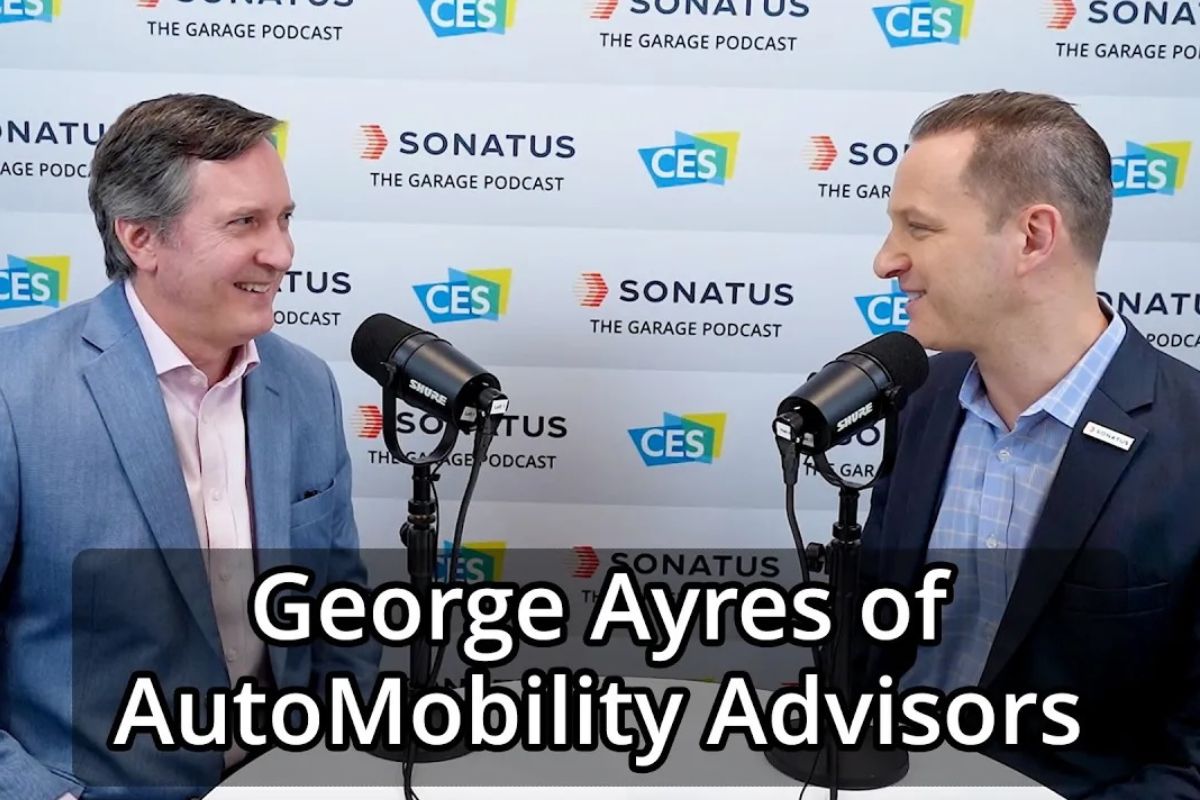
The Garage Podcast
George Ayres of AutoMobility Advisors
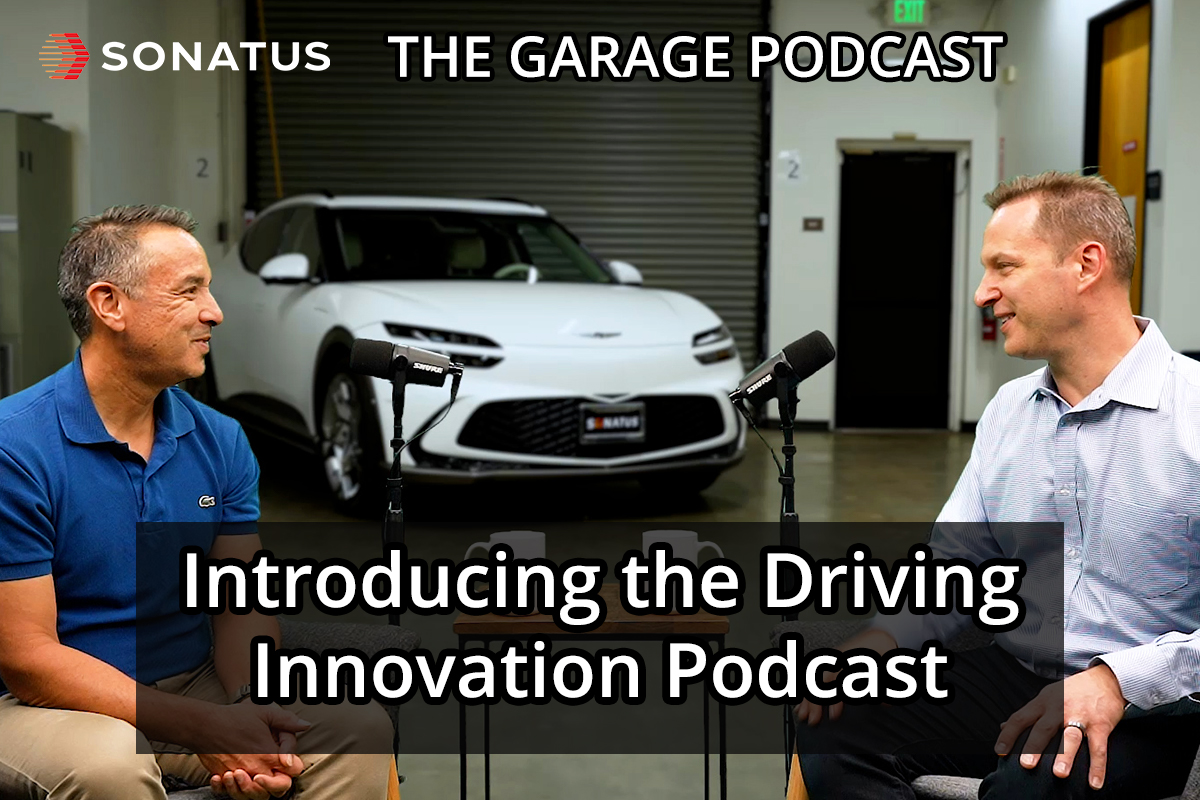
The Garage Podcast
Introducing the Driving Innovation podcast
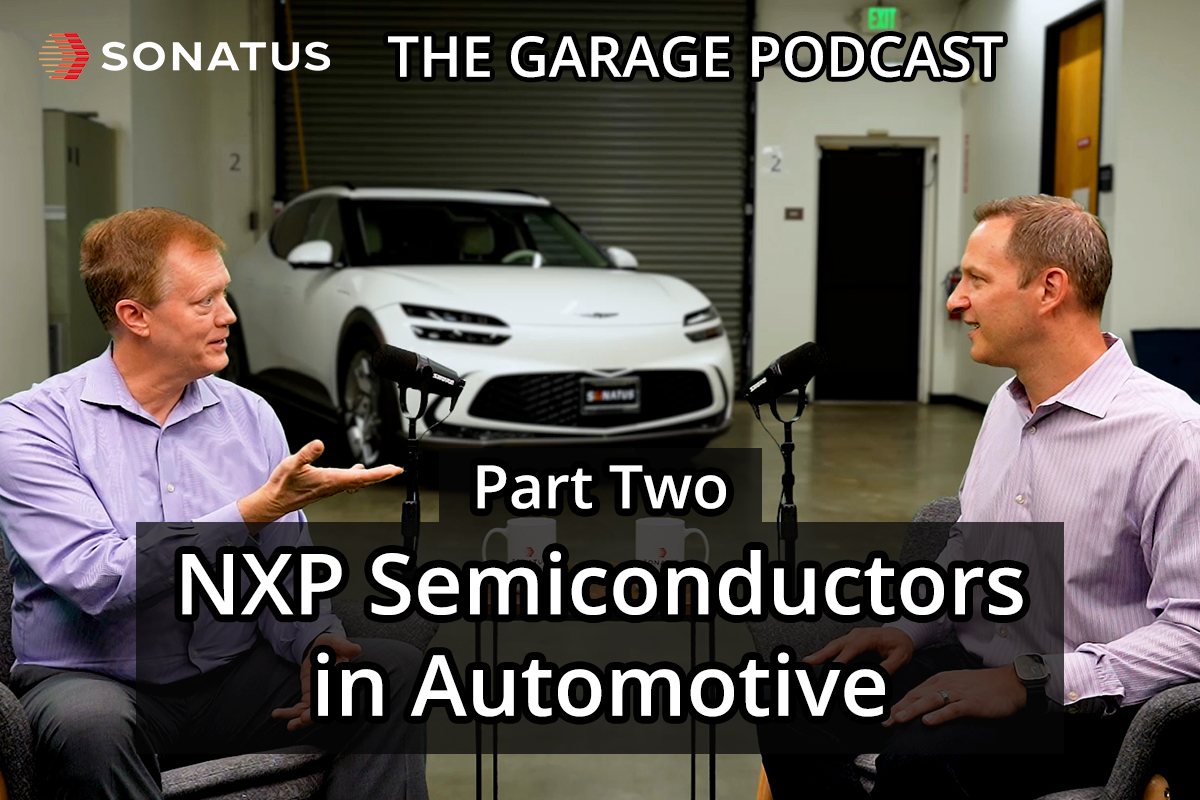
The Garage Podcast
NXP Semiconductors in Automotive, Part 2 of 2
Related resources
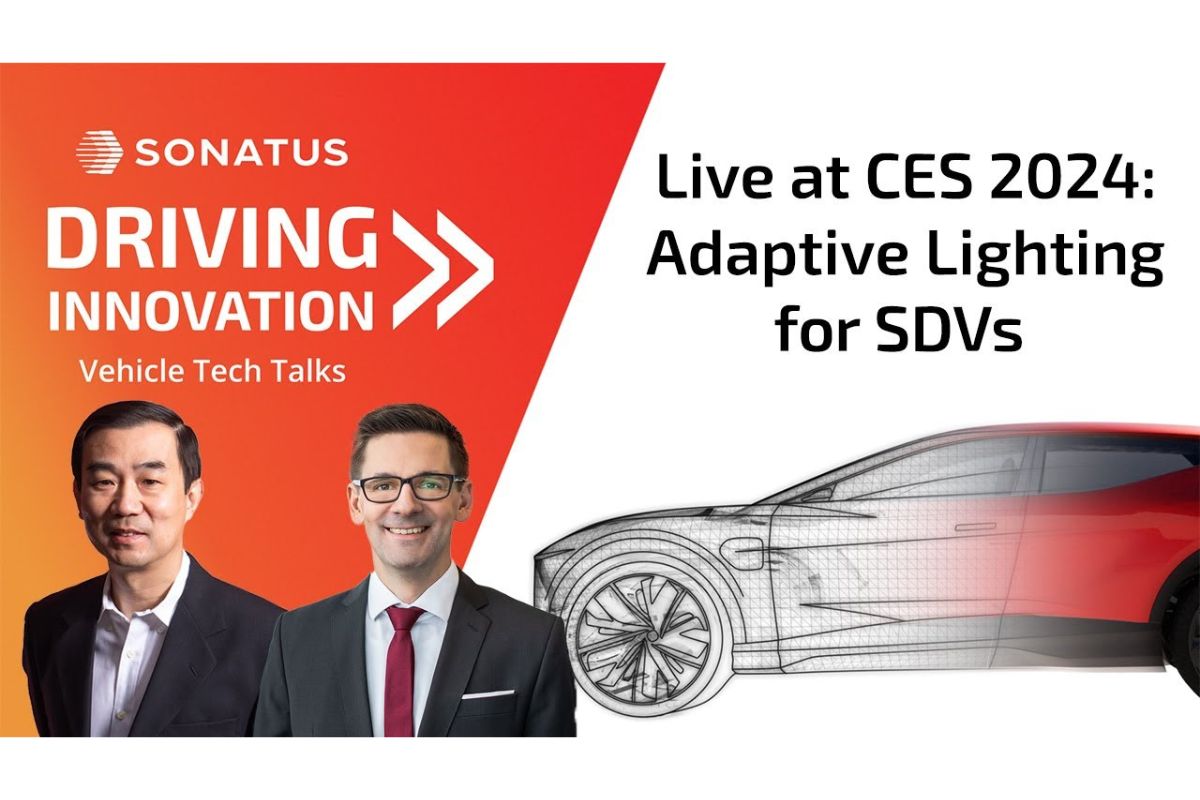
Adaptive Lighting for SDVs
In this episode, recorded live at CES 2024, Michael Rosenauer, Plastic Omnium Director of Innovation, Lighting Division and Yu Fang, Sonatus CTO, present the collaboration between the two companies to activate innovative lighting from Plastic Omnium using the flexible Sonatus Automator platform that can enable dynamic actions from the vehicle.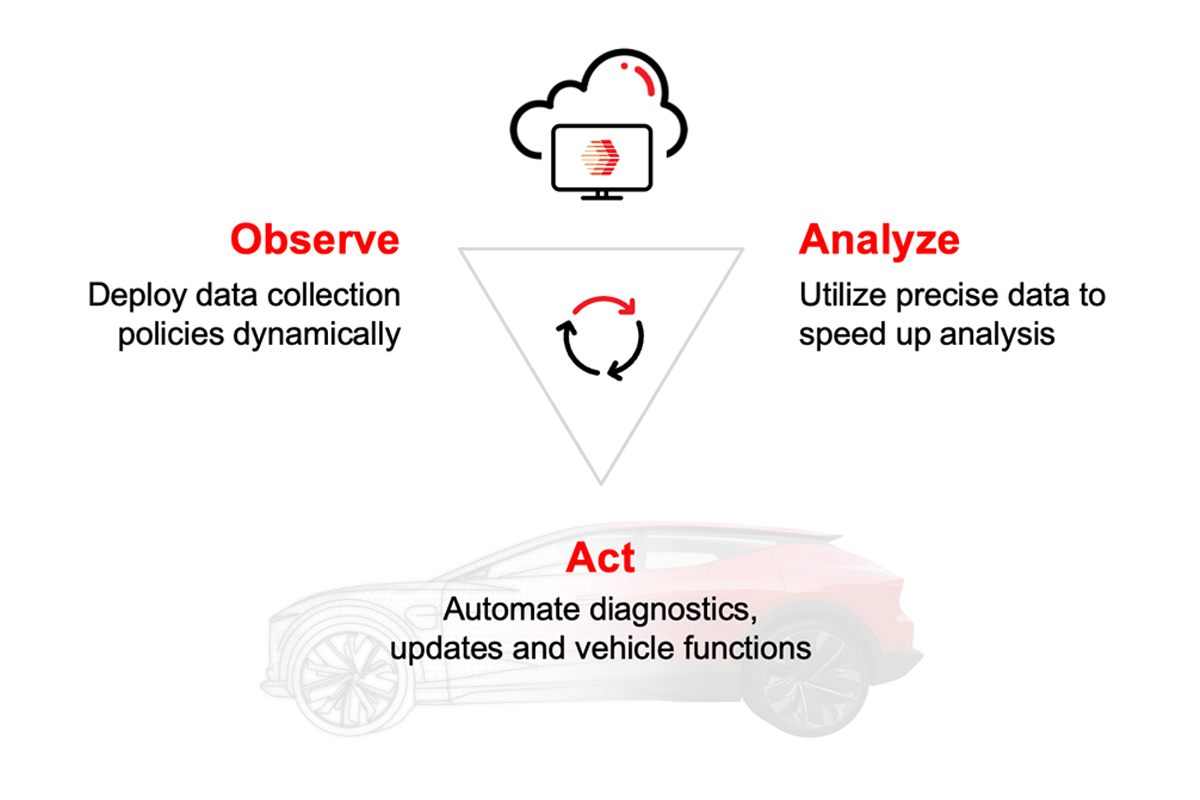
Two new solutions for Software-Defined Vehicles
Today Sonatus announced two compelling new solutions based on the Sonatus Vehicle Platform: Sonatus Vehicle Personalization and Software-Defined Component. These…